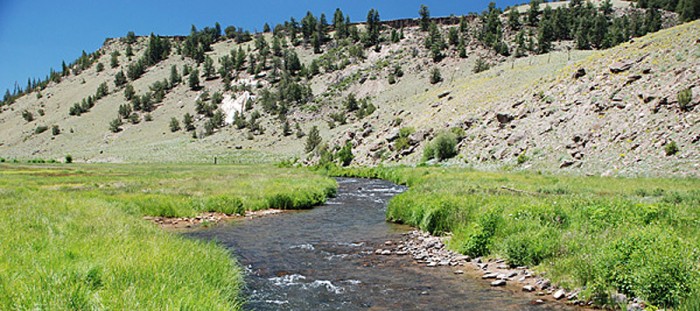Field Sport Concepts affiliate, Trout Headwaters, Inc. stream and wetland restoration project benefits Colorado mountain ranch property.
Stream and wetland restoration work was completed on the Sleeping Dog Ranch during early spring of 2009. The project was an acclaimed success and is described in this brief case study by FSC affiliate, Trout Headwaters, Inc.
Tumbling out of the San Juan Mountains into the Powderhorn Valley, Cebolla Creek gains speed and volume as it collects water from hillside springs and mountain snowmelt. Making its way north to Blue Mesa Reservoir in Gunnison County, the Cebolla offers some of the best dry fly fishing in Colorado.
Problem – Both Cebolla Creek and the existing wetlands on the Sleeping Dog Ranch had been degraded by years of agricultural practices such as ditching, filling, grazing, and dredging. More than 6,600 linear feet of Cebolla Creek on the property had been straightened; and roughly 50 acres of existing wetlands adjacent to the stream had been eroded. Trout Headwaters used a two-phase approach in addressing these conditions.
Stream Restoration Solution – In this first phase, Trout Headwaters’ design focused on restoring the areas of the degraded stream and creating new water channels, while also preserving and utilizing areas that had not been destroyed. The majority of the new channel construction reclaimed abandoned meanders that still existed. Their design enhanced the sinuosity and stream frontage of Cebolla Creek. Completion of this phase resulted in increasing the quality and diversity of aquatic habitat within the channel and riparian buffer zone.
Areas of stream bank erosion were biostabilized by using erosion control blankets and turf reinforcement materials in conjunction with native seeding, willow cuttings, and containerized plantings. Permanent seeding with native vegetation aided stabilization of all disturbed soils and provided nesting material, food and cover for wildlife.
Channel reconfiguration employed self-sustaining scour structures and deepened pools. The increased depth of pools slowed the velocity of water through the property, increased groundwater recharge rates, and expanded the footprint of riparian wetlands.
Wetland Restoration Solution – Having greater than normal soil moisture, wetlands are more productive than the surrounding upland areas and add to the overall diversity of the landscape. They attract wildlife for forage, thermal cover, and nesting habitat. The desired condition is a biologically-diverse, wetland complex. Addressing and improving the inflow and outflow systems of the wetlands will improve water quality.
Restored riparian buffer zones, including a mixture of planting zones, enhanced property resources such as aesthetic appeal, ground water recharge and wildlife habitat, restored the integrity of wetland areas, and provided recreational opportunities. Optimum habitats included clear, clean water with adequate dissolved oxygen, well-vegetated, stable banks and abundant in-pond cover. Enhanced wetlands also functioned as a filtering system for overland flow.
Results – The final design achieved restoration and enhancement of nearly six acres of wetland by dip-only excavation, an ecologically and economically sound construction practice; restoration of 4,500 linear feet of Cebolla Creek; and construction of 4,000 linear feet of new stream channel were restored to appropriate and stable geomorphology. Stabilized geomorphic functions included improved sediment transport, pool formation, and nutrient transport. Completion of this project actively benefited the health of aquatic and terrestrial resources on the property and also improved water quality and flood plain function for downstream and neighboring properties.
Photography © Trout Headwaters, Inc.

